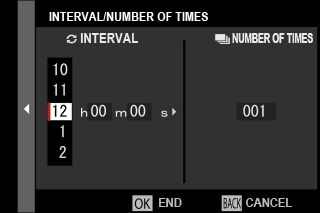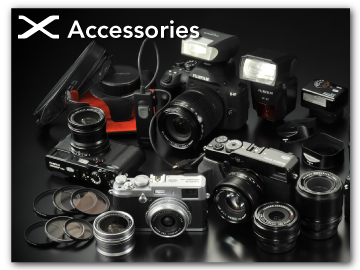[SHOOTING SETTING] (Still Photography)
Adjust shooting options for still photography.
To display shooting settings, press [MENU/OK] in the photo shooting display and select the A ([SHOOTING SETTING]) tab.

[SCENE POSITION]
Choose a scene for [SP] mode (a[SP] [SCENE POSITION ]).
[FILTER SETTING]
Choose the filter used when the mode dial is rotated to [FILTER] (a[FILTER ]).
[SPORTS FINDER MODE]
Take pictures using the crop in the center of the display. Choose this option for pictures of athletes, birds, and other moving subjects.

| Option | Description |
|---|---|
| [ON] | Pictures are taken using a 1.25× crop, reducing the picture angle by an amount equivalent to increasing lens focal length by 1.25×; the crop is shown by a frame in the display. |
| [OFF] | The 1.25× crop is disabled. |
The H[IMAGE QUALITY SETTING] > [IMAGE SIZE] item in the shooting menu is fixed at P.
The sports finder is not available in modes that offer an electronic shutter.
[PRE-SHOT]sJ
To reduce the lag between your pressing the shutter button all the way down and the resulting picture being recorded to the memory card, the camera starts shooting with the electronic shutter when the shutter button is pressed halfway and saves a series shots starting just before the shutter button is pressed the rest of the way down.
| Options | |
|---|---|
| [ON] | [OFF] |
Pre-shot photography is available only when s [ELECTRONIC SHUTTER] is selected in [CH] (high speed burst) drive mode (a[SHUTTER TYPE]).
[SELF-TIMER]
Choose a shutter release delay.
| Option | Description |
|---|---|
| R[2 SEC] | The shutter is released two seconds after the shutter button is pressed. Use to reduce blur caused by the camera moving when the shutter button is pressed. The self-timer lamp blinks as the timer counts down. |
| S[10 SEC] | The shutter is released ten seconds after the shutter button is pressed. Use for photographs in which you wish to appear yourself. The self-timer lamp blinks immediately before the picture is taken. |
| [OFF] | Self-timer off. |
If an option other than [OFF] is selected, the timer will start when the shutter button is pressed all the way down. The display shows the number of seconds remaining until the shutter is released. To stop the timer before the picture is taken, press [DISP/BACK].

Stand behind the camera when using the shutter button. Standing in front of the lens can interfere with focus and exposure.
The self-timer turns off automatically when the camera is turned off.
[SAVE SELF-TIMER SETTING]
If [ON] is selected, the chosen self-timer setting will remain in effect after a picture is taken or the camera is turned off.
| Options | |
|---|---|
| [ON] | [OFF] |
[SELF-TIMER LAMP]
If [ON] is selected, the self-timer lamp will light during self-timer photography. Select [OFF] when shooting night scenes or in other situations in which you would prefer that the lamp remain unlit.
| Options | |
|---|---|
| [ON] | [OFF] |
[INTERVAL TIMER SHOOTING]
Configure the camera to take photos automatically at a preset interval.
-
Select A [SHOOTING SETTING] in the shooting menu, highlight [INTERVAL TIMER SHOOTING], and press [MENU/OK].

-
Use the focus stick (focus lever) to choose the interval and number of shots. Press [MENU/OK] to proceed.

-
Use the focus stick to choose the starting time and then press [MENU/OK]. Shooting will start automatically.

Interval timer photography cannot be used at a shutter speed of [B] (bulb) or with multiple exposure photography. In burst mode, only one picture will be taken each time the shutter is released.
Use of a tripod is recommended.
Check the battery level before starting. We recommend using USB power source (a[USB POWER SUPPLY SETTING]).
The display turns off between shots and lights a few seconds before the next shot is taken.
The display can be activated at any time by pressing the shutter button.
To continue shooting until the number of shots taken equals the number of exposures remaining at the time interval-timer photography started, set the number of shots to ∞.
[INTERVAL TIMER SHOOTING EXPOSURE SMOOTHING]
Select [ON] to automatically adjust exposure during interval-timer photography to prevent it changing dramatically between shots.
| Options | |
|---|---|
| [ON] | [OFF] |
Large changes in subject brightness may make exposure appear erratic. We recommend that you choose shorter values for [INTERVAL TIMER SHOOTING] > [INTERVAL] with subjects that brighten or dim dramatically during shooting.
In manual mode (mode [M]), exposure smoothing is only available if an AUTO option is selected for sensitivity.
[AE BKT SETTING]
Adjust exposure bracketing settings.
| Option | Description |
|---|---|
| [FRAMES/STEP SETTING] |
Choose the number of shots in the bracketing sequence and the amount exposure is varied with each shot.
|
| [1 FRAME/CONTINUOUS] |
|
| [SEQUENCE SETTING] | Choose the order in which the shots are taken. |
[FILM SIMULATION BKT]
Choose the three film simulation types used for film simulation bracketing (a[FILM SIMULATION]).
[FOCUS BKT SETTING]
Choose from [AUTO] and [MANUAL] focus bracketing modes (aZ [FOCUS BKT]).
[PHOTOMETRY]
Choose how the camera meters exposure (a[Metering]).
[SHUTTER TYPE]
Choose the shutter type. Choose the electronic shutter to mute the shutter sound.
| Option | Description |
|---|---|
| t[MECHANICAL SHUTTER] | Take pictures with the mechanical shutter. |
| s[ELECTRONIC SHUTTER] | Take pictures with the electronic shutter. |
| u[MECHANICAL + ELECTRONIC] | The camera chooses the mechanical or electronic shutter according to shooting conditions. |
When using the electronic shutter, note the following:
- Distortion may be visible in shots of moving subjects.
- Distortion may also be visible in hand-held shots taken at high shutter speeds; use of a tripod is recommended.
- Banding and fog may occur in shots taken under fluorescent lights or other flickering or erratic illumination.
- When taking pictures with the shutter muted (a[SHUTTER VOLUME]), respect your subjects' image rights and right to privacy.
The following restrictions apply when the electronic shutter is used:
- “Extended” sensitivity values are not supported
- Long exposure noise reduction has no effect
- The flash cannot be used
[FLICKER REDUCTION]
Reduce flicker in pictures and the display when shooting under fluorescent lighting and other similar light sources.
| Option | Description |
|---|---|
| [ALL FRAMES] | Flicker reduction is performed for all frames. Compared to when flicker reduction is performed only on the first frame, the frame advance rate for burst photography will drop. |
| [FIRST FRAME] | Flicker reduction is performed for the first frame only; in burst photography, the value measured for the first frame in each burst will be used for all subsequent shots. Flicker may be visible during burst photography. |
| [OFF] | Flicker reduction disabled. |
Flicker reduction increases the time needed to record pictures.
[OFF] is selected for [FLICKER REDUCTION] when the electronic shutter is used.
Flicker reduction is not available during movie recording.
[IS MODE]
Reduce blur caused by camera shake or subject motion.
| Option | Description |
|---|---|
| L [CONTINUOUS + MOTION] | Image stabilization on. If [+ MOTION] is selected, the camera will adjust shutter speed to reduce motion blur when moving objects are detected. |
| l [CONTINUOUS] | |
| M [SHOOTING + MOTION] | As above, except that image stabilization is performed only when the shutter button is pressed halfway (focus mode k only) or the shutter is released. If [+ MOTION] is selected, the camera will adjust shutter speed to reduce motion blur when moving objects are detected. |
| m [SHOOTING ONLY] | |
| [OFF] | Image stabilization off. Choose this option when using a tripod. |
[+ MOTION] has no effect when sensitivity is set to a fixed value, and may also be unavailable at some other combinations of settings. The effect may vary with lighting conditions and the speed at which the object is moving.
[ISO]
Adjust the camera's sensitivity to light (aSensitivity).
xF[WIRELESS COMMUNICATION]
Connect to smartphones running the latest version of the FUJIFILM Camera Remote app. The smartphone can then be used to:
- Control the camera and take pictures remotely
- Receive pictures uploaded from the camera
- Browse the pictures on the camera and download selected pictures
- Upload location data to the camera
For downloads and other information, visit:

 .
.

